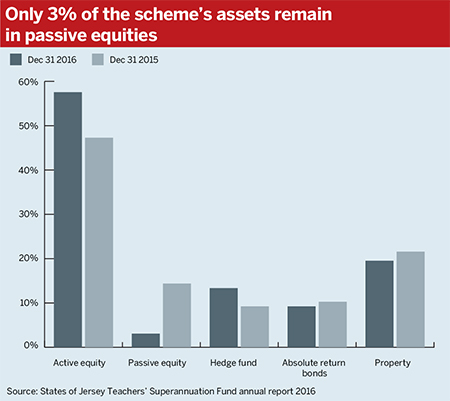The States of Jersey Teachers’ Superannuation Fund has bucked the current trend away from active management and increased its exposure to active equities, reducing index shares.
The scheme’s decision to place its faith in active management will puzzle some onlookers; passive funds grew four-and-a-half times faster than the active management industry in 2016, according to Morningstar data.
While passively managed investments look set to continue their rise in popularity, hope remains for active investments. Consultancy PwC has projected that global assets run by active managers will rise to $74tn (£54.6tn) by the end of 2020 from its 2015 level of $58.4tn (£43.1tn), which represents a 26.7 per cent increase.
If you have a 20-year view, passive has a lot of question marks, given how popular it is today
Eugene Barbaneagra, SEI
The same research anticipates passive assets under management rising to $23.2tn (£17.1tn) by the end of 2020, from $11.3tn (£8.3tn) in 2015.
Should schemes move from passive to active?
The fund’s latest annual report indicates a 10 percentage point rise – to 56 per cent – in its allocation to actively managed equities, while passively managed equities have dropped to just 3 per cent from a previous 14 per cent of total assets. The fund declined to comment on the changes.
William Marshall, head of Local Government Pension Scheme investment at consultancy Hymans Robertson, said the move could be indicative of the scheme having put pressure on managers to pay lower fees.
“As an industry, they seem to have sharpened their pencils in terms of fees, so maybe they’ve been able to negotiate more competitive terms,” he said.

“On the local government side we’ve definitely seen fees starting to reflect the scale of assets [within pools],” he added.
Reflecting upon the debate between active and passive management, Marshall said that a lot comes down to the fund’s governance budget. “With a very light level of governance, the passive can appeal,” he remarked.
Active management is more readily available to those “who have got more resource, who can handle a bit more governance”.
Start by exploring different markets
The Jersey scheme’s annual report did not separate its equity investments by country, but geography plays an important role in deciding a scheme’s position towards active and passive management.
Andrew Wauchope, senior investment director at Psigma Investment Management, identified the US as a market ripe for passive investment, owing to the difficulties active managers have faced there in outperforming benchmarks after fees.
Asian markets, on the other hand, have seen many active managers outperform their passive counterparts, and a shift towards equities in this space would likely result in a higher exposure to actively managed equities.
“We would be active where the information ratio is such that managers can add value,” he said.
“The decision between active and passive is really a reflection of who can perform the best in the markets you wish to be in.”
There is a need for active management
Active managers continue to make the case for their investment style in the face of growing criticism over their performance relative to passive management. Their role as capital allocators is often used to justify a long-term need for the practice.
Eugene Barbaneagra, portfolio manager and senior analyst at SEI, said the move from passive to active equity management made sense for a long-term investor.
“The job of capital allocators… is to make sure that the capital is allocated in the places where it can be deployed most efficiently,” he said.
What to look for in an active manager
 The question of active versus passive management never really gets answered. Various market participants have their own views on each approach, often depending on what time period is considered.
The question of active versus passive management never really gets answered. Various market participants have their own views on each approach, often depending on what time period is considered.
“If people no longer take into account future opportunities of those investments, and the future risks of those investments, then the capital is no longer allocated efficiently. To an extreme, capitalism will cease to function,” he added.
Long-term investors have been cautioned over a potential bubble created by rapid flows into passive management.
“If you have a 20-year view, passive has a lot of question marks, given how popular it is today,” he said.














